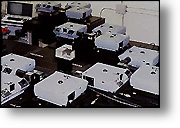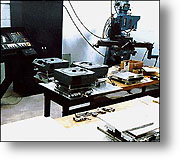ENGINEERINGRobin has a varied mechanical background that began with an interest in mechanics, and subsequently extended to every new interest over the years. Originally certified as a automotive gas and diesel mechanic in 1964, these skills eventually extended to welding, machinist, shipwright and finally optical engineering. Over the years there have been dozens of race and show cars, boats, and photographic hardware. 
The creation of the multi projector created considerable optical challenges due to the mirror action on the reflected face of the prism. Any deviation from a perfect right angle along any axis would cause the flat image of a slide to rotate within an imaginary sphere of rotation causing focus and color rendition problems. 
The mechanical side of this equation was solved with careful Z - Y - Z adjustor plates and lens mounts that were then carefully aligned to exact right angles using an optical alignment device of robins design. 
The size of the rooms themselves became a consideration as you can see even on the small AVT 15 projector shown here how far the image must travel from the initial projector to the camera. Vibration as well as alignment was a constant enemy as movement of an individual image within a sequence was a 100% failure from the producers viewpoint. 
Optical resolution of this equipment retained three in five circles of optical resolution, or in common terms met ANSI 70mm film resolution standards. At the time the 21 projector table was constructed Robin spent almost a year in optical flat facilities and optical coating facilities supervising and testing the components and coatings. This form of engineering is sparsely populated with few practitioners where you can count the world experts on your fingers. As a matter of interest the final optical path on the 21 projector multiplexer was 21 feet in length and one of the most difficult technical problem was to custom design a beam splitter coating which would allow the red, blue and green light to be at the same plane of focus when it reached the tubes of a video camera due to the difference in wavelengths allowing video images to remain sharp. 
This necessitated the construction of laser bed optical tables. the size of these tables was massive and construction a piece of fine joinery. The first units were constructed from huge air dried cedar 4 x 4 beams joined with dovetails, while later versions were built using a plywood monocoque structure. 
Table tops were massive with the large center units for the 9 projector beds measuring over nine feet across and weighing 600 lbs. Any heat variation would cause the beam splitter mount to expand or contract requiring heat dissipation considerations as well as rigidity and flatness considerations.  Now that the optical benches or multiplexers were built it was Robins responsibility to supervise and build the broadcast video and film portion of the facility. This would usually include a 1 inch video system, 3/4 inch video system, off line edit systems, duplication systems, video and film camera systems. 
The final stages of the Slide to film and telecine period came in the United States where first with AVT then as Morrish Research and Design there were several smaller ventures and insulations such as the Video Producer which was a franchise unit marketed in 1985. |